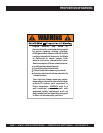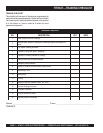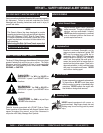
PAGE 10 — HTH44T • RIDE-ON POWER TROWEL — OPERATION AND PARTS MANUAL — REV. #8 (03/27/12)
)
HTH44T— RULES FOR SAFE OPERATION
CAUTIONCAUTION
CAUTIONCAUTION
CAUTION
Failure to follow instructions in this manual may
lead to serious injury or even death! This
equipment is to be operated by
trained and
qualified personnel only! This equipment is
for industrial use only and should not be
regarded as a toy.
The following safety guidelines should always be used when
operating the HTH44T Ride-on Power Trowel:
GENERAL SAFETY
■
DO NOT operate or service this equipment before reading
this entire manual.
■
This equipment should not be operated by persons under
18 years of age.
■
DO NOT operate this equipment unless all guards and
safety devices are attached and in place.
■
ALWAYS use proper
heavy
lifting techniques when moving
equipment. This ride-on trowel is very heavy. It should be
lifted only with a lifting device (i.e. crane, forklift, etc.) with
a lifting capacity of at least one ton.
■
ALWAYS check to make sure that the operating area is
clear before starting the engine.
■
ALWAYS test the safety
kill switch
before operating the
equipment.
■
NEVER place your feet inside the guard rings while starting
or operating this equipment.
■
NEVER operate this equipment without proper
protective
clothing, shatterproof glasses, steel-toed boots and other
protective devices required by the job. Avoid wearing
jewelry or loose fitting clothing that may snag on the controls
or moving parts, this can cause a serious injury.
■
ALWAYS keep clear of rotating or moving parts while
operating this equipment.
■
NEVER leave the machine
unattended
while running.
■
ALWAYS refuel in a well-ventilated area, away from sparks
and open flames.
■
ALWAYS use extreme caution when working with
flammable liquids
. When refueling,
stop the
engine and
allow it to cool
.
DO NOT
smoke around or near the machine.
Fire or explosion could result from flames or sparks, or if
fuel is spilled on a hot engine.
■
Moving Parts – Shut down the engine before performing
service or maintenance functions. Contact with moving
parts can cause serious injury.
■
High Temperatures – Allow the machine
and engine to cool before adding fuel or
performing service and maintenance
functions. Contact with
hot
components can
cause serious burns.
Emergencies
■
ALWAYS know the location of the
nearest
fire extinguisher
and
first aid kit
.
Know the location of the nearest telephone.
Also know the phone numbers of the
nearest
ambulance
,
doctor
and
fire
department
. This information will be
invaluable in the case of an emergency.
Maintenance Safety
■
Disconnect the battery and spark plug wires before
attempting any type of service.
■
Securely support any machine components that must be
raised.
■
NEVER lubricate components or attempt service on a
running machine.
■
ALWAYS allow the machine a proper amount of time to
cool before servicing.
■
Keep the machinery in proper running condition.
■
Make sure that there is no buildup of concrete, grease, oil
or debris on the machine.
■
Fix damage to the machine immediately and always replace
broken parts.
■
Dispose of hazardous waste properly. Examples of
potentially hazardous waste are used motor oil, fuel and
fuel filters.
■
DO NOT use food or plastic containers to dispose of
hazardous waste.
■
DO NOT pour waste, oil or fuel directly onto the ground,
down a drain or into any water source.


















